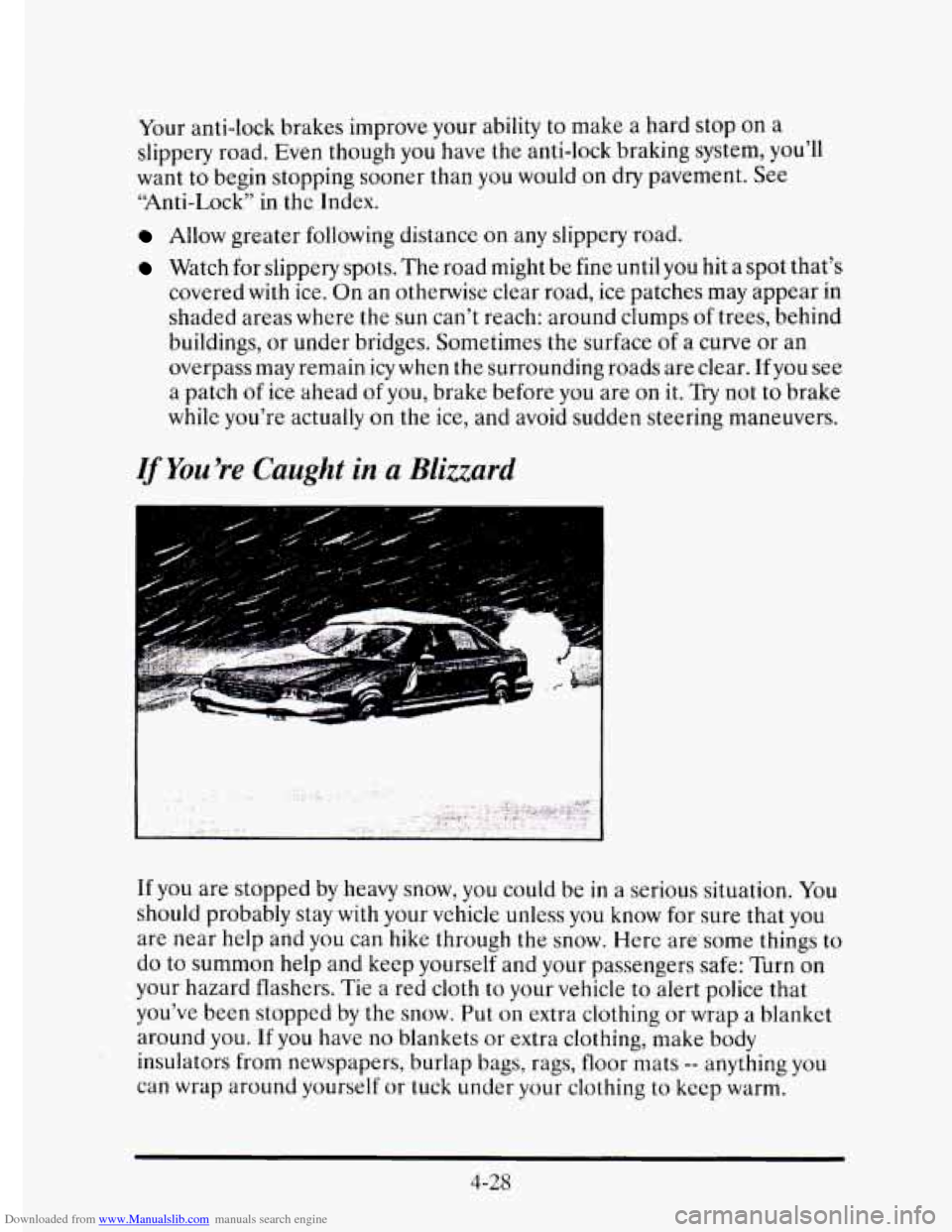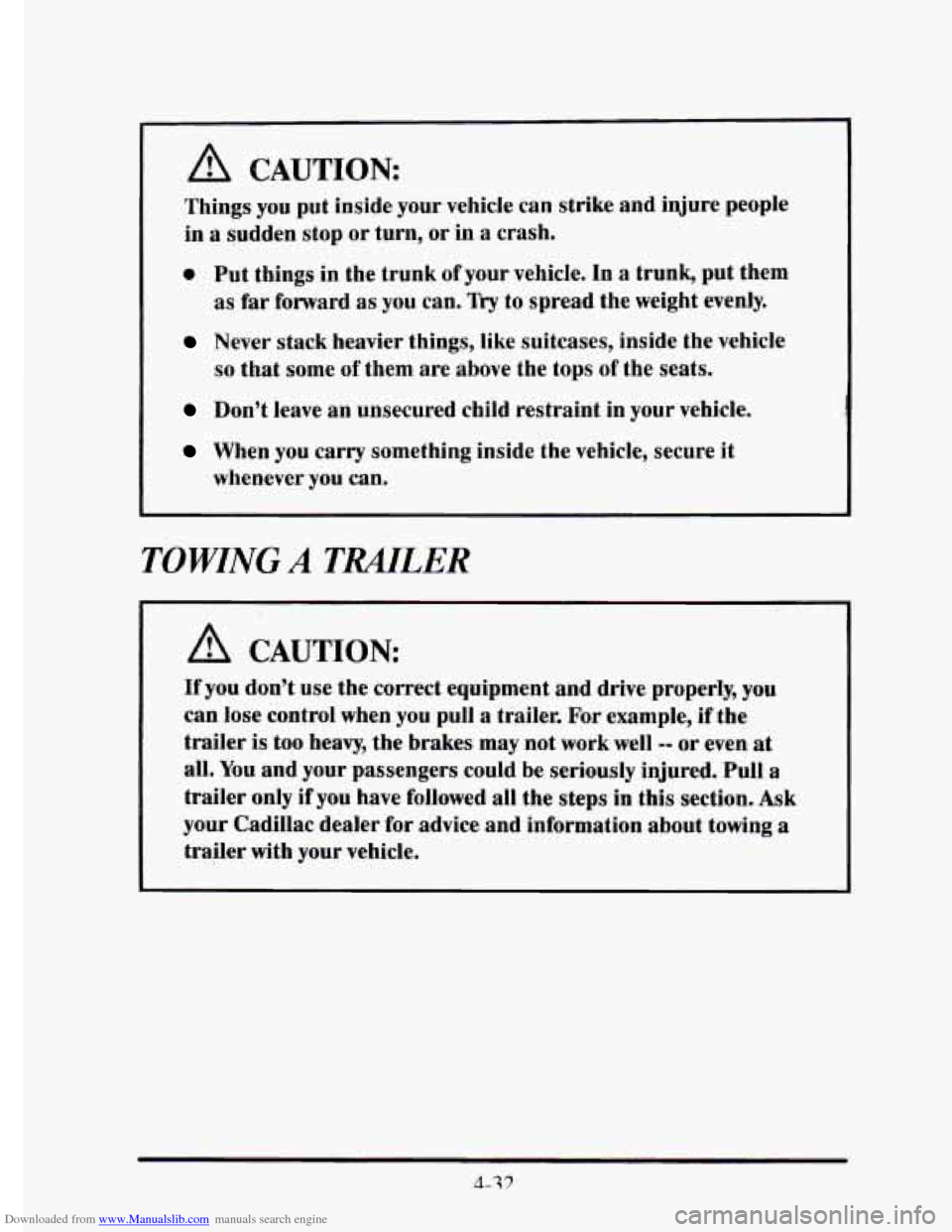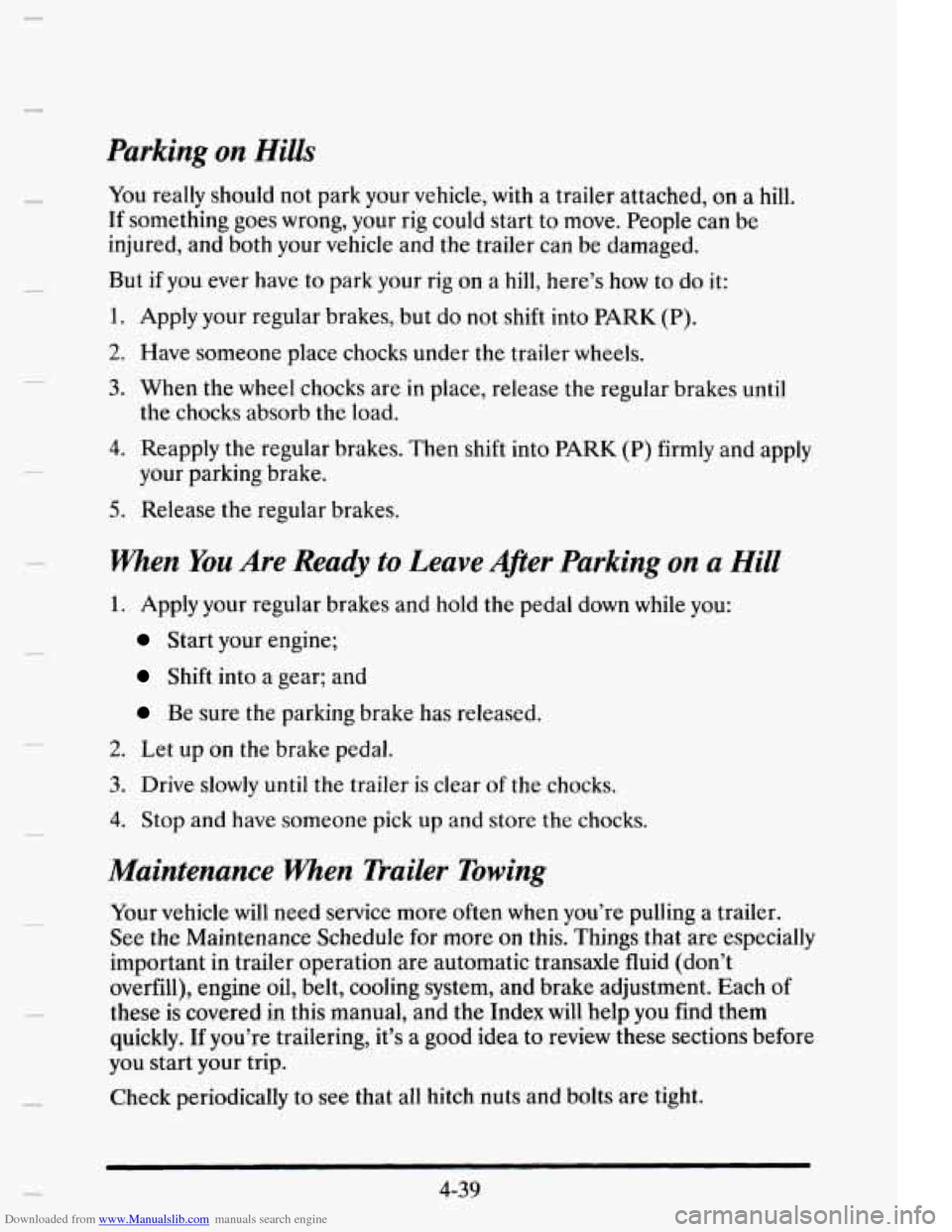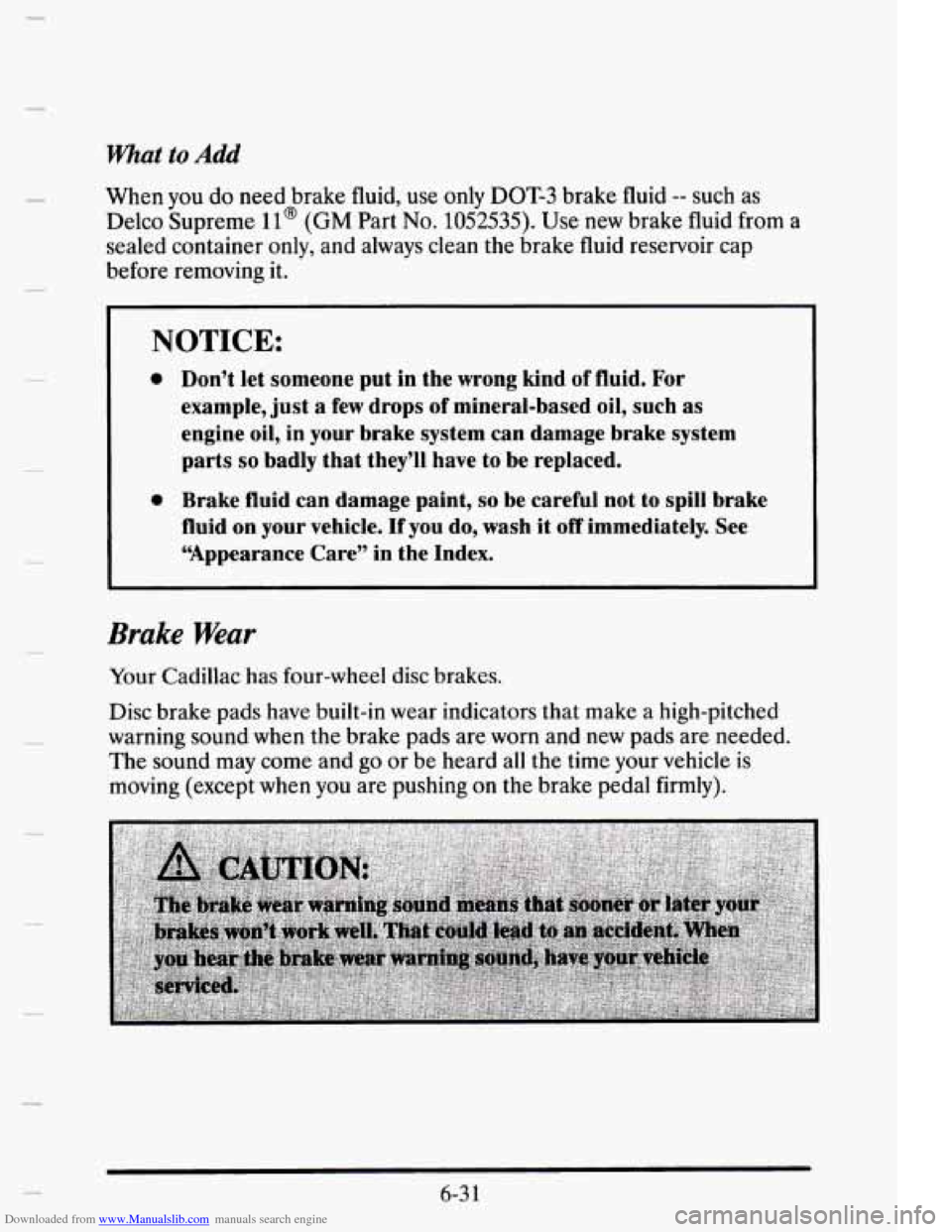1995 CADILLAC ELDORADO brakes
[x] Cancel search: brakesPage 215 of 395

Downloaded from www.Manualslib.com manuals search engine Your anti-lock brakes improve your ability to make a hard stop on a
slippery road. Even though you have the anti-lock braking system, you’ll
want
to begin stopping sooner than you would on dry pavement. See
“Anti-Lock” in the Index.
Allow greater following distance on any slippery road.
Watch for slippery spots. The road might be fine until you hit a spot that’s
covered with ice. On an otherwise clear road, ice patches may appear in
shaded areas where
the sun can’t reach: around clumps of trees, behind
buildings, or under bridges. Sometimes the surface
of a curve or an
overpass may remain icy when
the surrounding roads are clear. If you see
a patch of ice ahead
of you, brake before you are on it. Try not to brake
while you’re actually on the ice, and avoid sudden steering maneuvers.
You’re Caught in a Blizzard
If you are stopped by heavy snow, you could be in a serious situation. You
should probably stay with your vehicle unless you know for sure that you
are near help and you can hike through
the snow. Here are some things to
do to summon help and keep yourself and your passengers safe: Turn on
your hazard flashers. Tie
a red cloth to your vehicle to alert police that
you’ve been stopped by the snow. Put on extra clothing
or wrap a blanket
around you.
If you have no blankets or extra clothing, make body
insulators from newspapers, burlap bags, rags, floor mats
-- anything you
can wrap around yourself or tuck under your clothing to keep warm.
4-28
Page 219 of 395

Downloaded from www.Manualslib.com manuals search engine A CAUTION
Things you put inside your vehicle can strike and injure people
in a sudden stop or turn, or in a crash.
0 Put things in the trunk of your vehicle. In a trunk, put them
as far forward as you can. ‘Ry to spread the weight evenly.
Never stack heavier things, like suitcases, inside the vehicle
so that some of them are above the tops of the seats.
Don’t leave an unsecured child restraint in your vehicle.
When you carry something inside the vehicle, secure it
whenever you can.
TOWING A TRAILER
A CAUTION:
If you don’t use the correct equipment and drive properIy, you
can lose control when you pull a trailer. For example, if the
trailer
is too heavy, the brakes may not work well -- or even at
all. You and your passengers could be seriously injured. Pull a
trailer only if you have followed all the steps in this section. Ask
your Cadillac dealer for advice and information about towing a
trailer with your vehicle.
Page 223 of 395

Downloaded from www.Manualslib.com manuals search engine Total Weight on Your khicle’s Tires
Be sure your vehicle’s tires are inflated to the recommended pressure for
cold tires. You’ll find these numbers on the Certification label
at the rear
edge
of the driver’s door or see “Loading Your Vehicle” in the Index.
Then be sure
you don’t go over the GVW limit for your vehicle, including
the weight of the trailer tongue.
Hitches
It’s important to have the correct hitch equipment. Crosswinds, large
trucks going by, and rough roads are a
few reasons why you’ll need the
right hitch. Here are some rules
to follow:
0 Will you have to makc any holes in the body of your vehicle when you
install a trailer hitch?
if you do, then be sure to seal the holes later
whcn
you remove the hitch. If you don’t seal them, deadly carbon
monoxide
(CO) from your exhaust can get into your vehicle (see
“Carbon Monoxide”
in the Index). Dirt and water can, too.
Safety Chains
You should always attach chains between your vehicle and your trailer.
Cross the safety chains under
the tongue of the trailer so that the tongue
will not drop to thc road if it becomes separated from the hitch.
Instructions about safety chains may be provided by the hitch
manufacturer or by the trailer manufacturer. Follow the manufacturcr’s
recommendation for attaching safety chains and do not attach them to the
bumper. Always leave
just enough slack so you can turn with your rig.
And, never allow safety chains to drag on the ground.
Trailer Brakes
Because you have anti-lock brakes, don’t try to tap into your vehicle’s
hydraulic brake system.
If you do, both brake systems won’t work well, or
at all.
Be sure to read and follow thc instructions for the trailer brakes so you’ll
be able to install, adjust and maintain them properly.
4-36
Page 224 of 395

Downloaded from www.Manualslib.com manuals search engine Driving with a Trailer
n Towing a trailer requires a certain amount of experience. Before setting
out for the open road, you’ll want to get to
know your rig. Acquaint
yourself with the feel
of handling and braking with the added weight of
the trailer. And always keep in mind that the vehicle you are driving is
now a good deal longer and not nearly as responsive as your vehicle is by
itself.
Before you start, check the trailer hitch and platform (and attachments),
safety chains, electrical connector, lamps, tires and mirror adjustment. If
the trailer has electric brakes, start your vehicle and trailer moving and
then apply the trailer brake controller by hand to be sure the brakes are
working. This lets you check your electrical connection at the same time.
. During your trip, check occasionally to be sure that the load is secure, and
that the lights and any trailer brakes are still working.
Following Distance
Stay at least twice as far behind the vehicle ahead as you would when
driving your vehicle without a trailer. This can help you avoid situations
that require heavy braking and sudden turns.
Passing
You’ll need more passing distance up ahead when you’re towing a trailer.
And, because you’re a good deal longer, you’ll need to
go much farther
beyond the passed vehicle before you can return to your lane.
Backing Up
Hold the bottom of the steering wheel with one hand. Then, to move the
trailer to the left, just move that hand to the left.
To move the trailer to
the right, move your hand to the right. Always back up slowly and,
if
possible, have someone guide you.
4-37
Page 225 of 395

Downloaded from www.Manualslib.com manuals search engine Making Turns
NOTICE:
Making very sharp turns while trailering could cause the trailer
to come in contact with the vehicle. Your vehicle could be
damaged. Avoid making very sharp turns while trailering.
When you’re turning with a trailer, make wider turns than normal. DO this
so your trailer won’t strike soft shoulders, curbs, road signs, trees, or other
objects. Avoid jerky or sudden maneuvers. Signal well in advance.
Turn Signals When Towing a Trailer
When you tow a trailer, your vehicle has to have a different turn signal
flasher and extra wiring. The green arrows on your instrument panel will
flash whenever you signal
a turn or lane change. Properly hooked up, the
trailer lamps
will also flash, telling other drivers you’re about to turn,
change lanes or stop.
When towing a trailer, the green arrows on your instrument panel
will
flash for turns even if the bulbs on the trailer are burned out. Thus, you
may think drivers behind you are seeing your
signal when they are not. It’s
important to
che.ck occasionally to be sure the trailer bulbs are still
working.
Driving On Grades
Reduce speed and shift to a lower gear before you start down a long or
steep downgrade.
If you don’t shift down, you might have to use your
brakes
so much that they would get hot and no longer work well.
4-38
Page 226 of 395

Downloaded from www.Manualslib.com manuals search engine Parking on Hills
c
You really should not park your vehicle, with a trailer attached, on a hill.
If something goes wrong, your rig could start to move. People can be
injured, and both your vehicle and the trailer can be damaged.
But
if you ever have to park your rig on a hill, here’s how to do it:
1. Apply your regular brakes, but do not shift into PARK (P).
2. Have someone place chocks under the trailer wheels.
3. When the wheel chocks are in place, release the regular brakes until
the chocks absorb the load.
4. Reapply the regular brakes. Then shift into PARK (P) firmly and apply
5. Release the regular brakes.
your parking
brake.
When You Are Ready to Leave Afier Parking on a Hill
1. Apply your regular brakes and hold the pedal down while you:
Start your engine;
Shift into a gear; and
Be sure the parking brake has released.
2. Let up on the brake pedal.
3. Drive slowly until the trailer is clear of the chocks.
4. Stop and have someone pick up and store the chocks.
Maintenance When Trailer Towing
Your vehicle will need service more often when you’re pulling a trailer.
See the Maintenance Schedule
for more on this. Things that are especially
important in trailer operation are automatic transaxle fluid (don’t
overfill), engine oil, belt, cooling system, and brake adjustment. Each
of
these is covered in this manual, and the Index will help you find them
quickly.
If you’re trailering, it’s a good idea to review these sections before
you start your trip.
Check periodically to see that all hitch nuts and bolts are tight.
4-39
Page 290 of 395

Downloaded from www.Manualslib.com manuals search engine Khat to Add
c
When you do need brake fluid, use only DOT-3 brake fluid -- such as
Delco Supreme
ll@ (GM Part No. 1052535). Use new brake fluid from a
sealed container only, and always clean the brake fluid reservoir cap
before removing it.
NOTICE:
e Don’t let someone put in the wrong kind of fluid. For
example, just a few drops of mineral-based oil, such
as
engine oil, in your brake system can damage brake system
parts
so badly that they’ll have to be replaced.
0 Brake fluid can damage paint, so be careful not to spill brake
fluid
on your vehicle. If you do, wash it off immediately. See
‘!Appearance Care” in the Index.
Brake Wear
Your Cadillac has four-wheel disc brakes.
Disc brake pads have built-in wear indicators that make a high-pitched
warning sound when the brake pads are worn and new pads are needed.
The sound may come and
go or be heard all the time your vehicle is
moving (except when you are pushing on the brake pedal firmly).
6-3 1
Page 291 of 395

Downloaded from www.Manualslib.com manuals search engine NOTICE:
Continuing to drive with worn-out brake pads could result in
costly brake repair.
Some driving conditions or climates may cause a brake squeal when the
brakes are first applied
or lightly applied. This does not mean something
is wrong
with your brakes.
Brake linings should always be replaced as complete axle sets.
Brake Pedal Travel
See your dealer if the brake pedal does not return to normal height, or if
there is a rapid increase in pedal travel. This could bc a sign of brake
trouble.
Brake Adjustment
Every time you apply the brakes, with or without the vehicle moving, your
brakes adjust for wear.
Replacing Brake System Parts
The braking system on a modern vehicle is complex. Its many parts have
to be
of top quality and work wcll together if the vehicle is to have really
good braking. Vehicles
we design and test have top-quality GM brake
parts in them,
as your Cadillac does when it is new. When you replace
parts of your braking system
-- for example, when your brake linings wear
down and
you have to have new ones put in -- be sure you get new
genuine
GM replacement parts. If you don’t, your brakes may no longer
work properly. For example,
if someone puts in brake linings that are
wrong for your vehicle,
the balance between your front and rear brakes
can change
-- for the worse. The braking performance you’ve come to
expect can change in many
other ways if someone puts in the wrong
replacement brake parts.
6-32